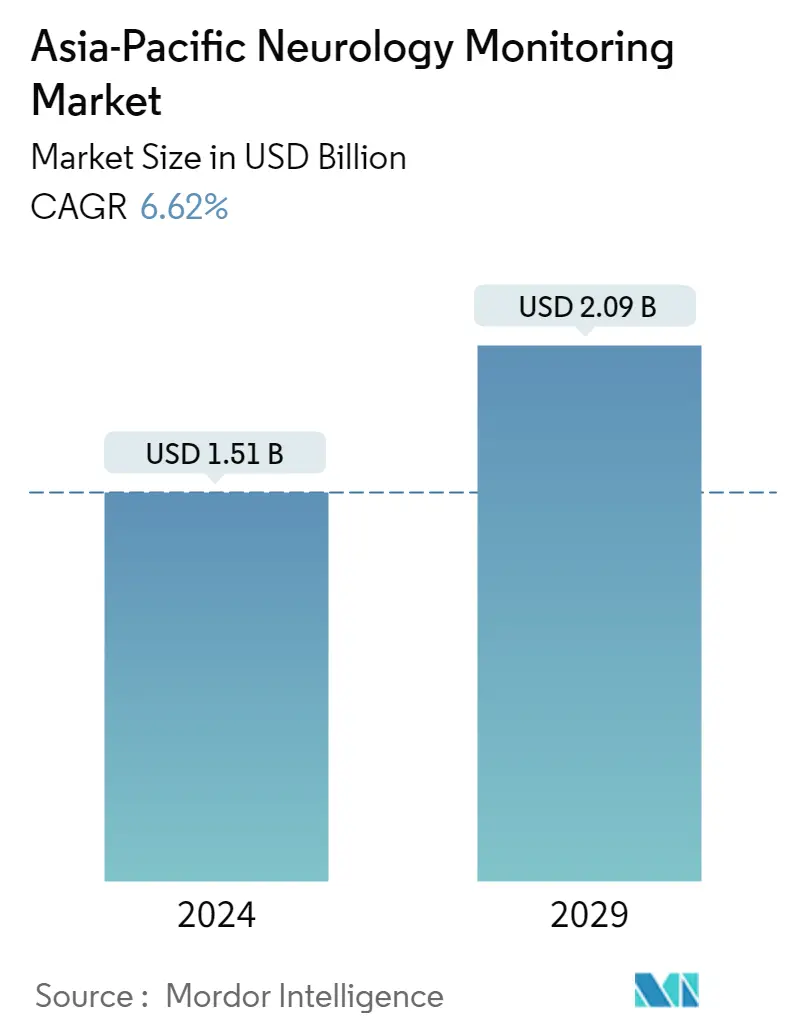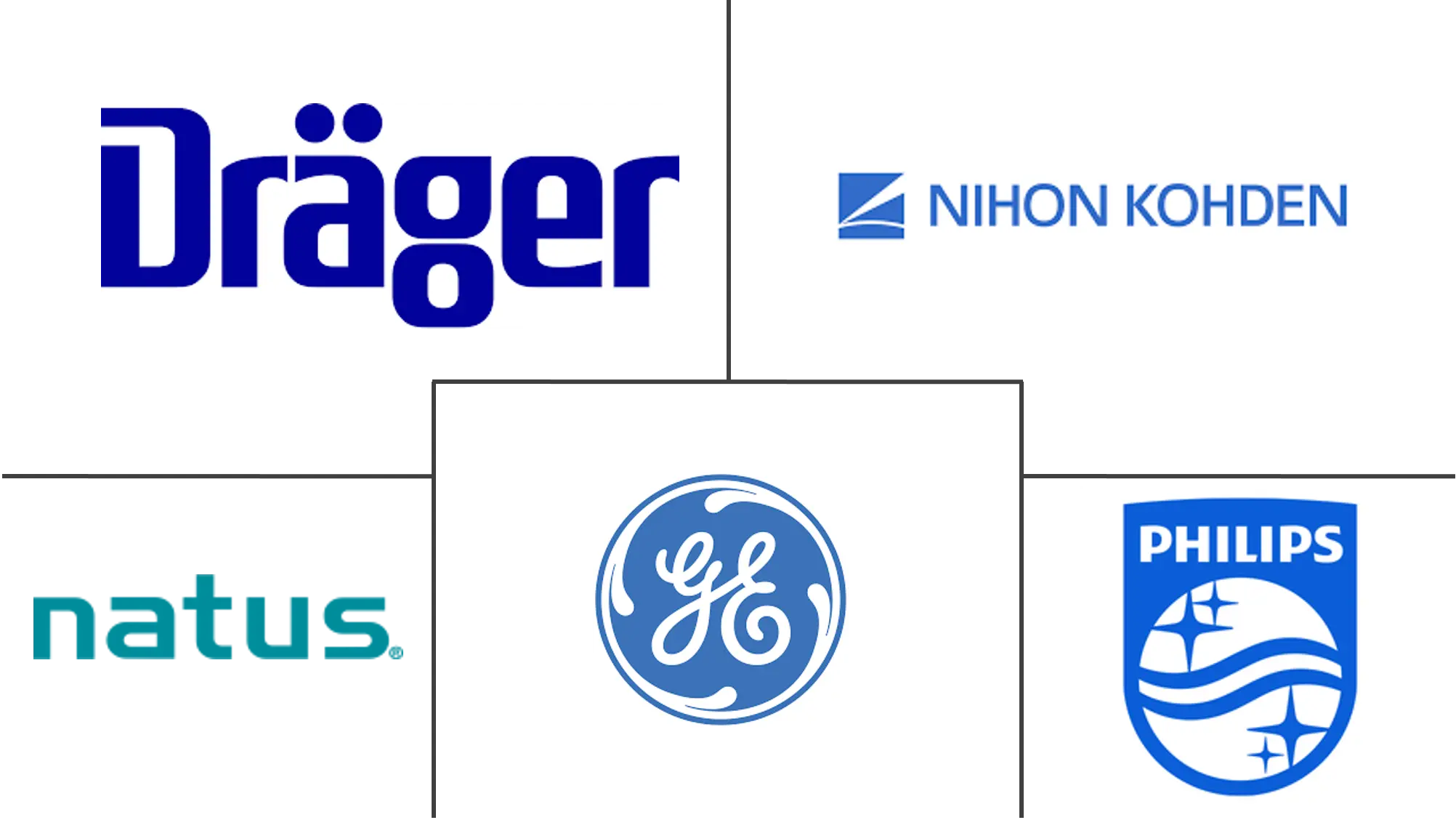Market Size of Asia-Pacific Neurology Monitoring Industry

| Study Period | 2019 - 2029 |
| Base Year For Estimation | 2023 |
| Market Size (2024) | USD 1.51 Billion |
| Market Size (2029) | USD 2.09 Billion |
| CAGR (2024 - 2029) | 6.62 % |
| Market Concentration | Medium |
Major Players
*Disclaimer: Major Players sorted in no particular order |
APAC Neurology Monitoring Market Analysis
The Asia-Pacific Neurology Monitoring Market size is estimated at USD 1.51 billion in 2024, and is expected to reach USD 2.09 billion by 2029, growing at a CAGR of 6.62% during the forecast period (2024-2029).
The impact of COVID-19 on the Asia-Pacific neurology monitoring market was adverse due to the cancellations of elective procedures, including diagnosis and treatment of neurological diseases. Individuals with neurological disorders were also at a higher risk for complications from COVID-19. For instance, in June 2020, the WHO issued the results of a survey conducted by 155 countries in May 2020. The results showed that the prevention and treatment services of various chronic diseases, including various neurodegenerative disorders, such as Parkinson's, Alzheimer, and dementia, had been severely disrupted. This was a significant concern as people with chronic diseases were at higher risk of severe COVID-19-related illness and death. However, the market started to gain traction as elective procedures and product developments resumed. With the increasing number of patients for neurological procedures, the market is expected to grow during the forecast period.
In addition, the increasing burden of neurological disorders and an increasing number of product approvals are affecting the market's growth. According to the Alzheimer's Disease Foundation, Malaysia (ADFM), the population of persons with dementia was estimated to be around 204,000 to 264,000 (8.5% to 11%) in 2020. This number is projected to reach 637,500 to 825,000 by 2050, an increase of 312%. Also, as per ADI, the burden of dementia in India is projected to rise by 197% by 2050. The high burden of neurological diseases in the region is projected to boost the utility of neurology monitoring devices during the forecast period.
The Asia-Pacific region has the fastest-growing market for neurology monitoring devices. Developing economies, like India and China, are making significant investments in healthcare and medical research and making advanced technologies more accessible and affordable. For instance, in September 2021, Zoho Corporation, India's one of largest SaaS providers, invested USD 5 million (INR 35 crore) in Voxelgrids for over 25% stake in the Bengaluru-based startup that builds magnetic resonance imaging (MRI) scanners. Such developments are projected to boost the usage of neurology monitoring devices in the region.
Technological advancements, increasing product approvals, partnerships, and acquisitions by key players are also helping market growth. For instance, in March 2022, Siemens Healthineers showcased its latest solution in the MRI portfolio, MAGNETOM Free.Star at the 74th National Conference, IRIA 2022, held in Bengaluru, India. Such developments are projected to boost the demand for MRI devices, which is ultimately projected to propel market growth.
Therefore, owing to the abovementioned factors, the market studied is anticipated to witness growth during the forecast period. However, the high cost of monitoring devices is likely to impede market growth.
APAC Neurology Monitoring Industry Segmentation
As per the scope of the report, neurology monitoring devices are used to monitor and diagnose neurological conditions by exploring the structure and functions of the brain. This process involves using several brain-monitoring devices to track and monitor brain functions. In addition, these devices help monitor neural and electrical activity in the brain. The Asia-Pacific neurology devices market is segmented by Product Type (Magnetic Resonance Imaging (MRI) Devices, Electroencephalography Devices, Cerebral Oximeters, Intracranial Pressure Monitors, and Other Product Types), Disease Type (Stroke, Sleep Disorders, Parkinson's Disease, Epilepsy, and Other Diseases), and Geography (China, Japan, India, Australia, South Korea, and Rest of Asia-Pacific). The report offers the value in USD million for the above segments.
| By Product Type | |
| Magnetic Resonance Imaging (MRI) Devices | |
| Electroencephalography Devices | |
| Cerebral Oximeters | |
| Intracranial Pressure Monitors | |
| Other Product Types |
| By Disease Type | |
| Stroke | |
| Sleep Disorders | |
| Parkinson's Disease | |
| Epilepsy | |
| Other Diseases |
| Geography | |
| China | |
| Japan | |
| India | |
| Australia | |
| South Korea | |
| Rest of Asia-Pacific |
Asia-Pacific Neurology Monitoring Market Size Summary
The Asia-Pacific neurology monitoring market is poised for significant growth, driven by the increasing prevalence of neurological disorders and advancements in medical technology. The region, particularly countries like India and China, is witnessing substantial investments in healthcare and medical research, making advanced neurology monitoring technologies more accessible. The market's expansion is further supported by the rising demand for Magnetic Resonance Imaging (MRI) devices, spurred by government initiatives to install these devices in hospitals to combat the growing incidence of neurological diseases. Despite the initial setbacks caused by the COVID-19 pandemic, which disrupted the diagnosis and treatment of neurological conditions, the market has rebounded as elective procedures resumed and product developments progressed.
Technological advancements, such as the introduction of AI-powered MRI reconstruction software and the establishment of sophisticated MRI facilities, are enhancing the capabilities and efficiency of neurology monitoring devices. The market is characterized by a moderately fragmented landscape, with both global and regional players like Natus Medical Inc., Siemens Healthineers, and GE Healthcare holding significant shares. Partnerships and acquisitions among key players are fostering innovation and expanding market reach. Additionally, the Indian government's support for local manufacturing through initiatives like the Production Linked Incentive Scheme is expected to boost the availability and affordability of neurology monitoring devices. These factors collectively contribute to the anticipated growth of the Asia-Pacific neurology monitoring market over the forecast period.
Asia-Pacific Neurology Monitoring Market Size - Table of Contents
-
1. MARKET DYNAMICS
-
1.1 Market Overview
-
1.2 Market Drivers
-
1.2.1 Increasing Burden of Neurological Disorders
-
1.2.2 Increasing Number of Product Approvals
-
-
1.3 Market Restraints
-
1.3.1 High Cost of Monitoring Devices
-
-
1.4 Porter's Five Force Analysis
-
1.4.1 Threat of New Entrants
-
1.4.2 Bargaining Power of Buyers/Consumers
-
1.4.3 Bargaining Power of Suppliers
-
1.4.4 Threat of Substitute Products
-
1.4.5 Intensity of Competitive Rivalry
-
-
-
2. MARKET SEGMENTATION (Market Size by Value - USD million)
-
2.1 By Product Type
-
2.1.1 Magnetic Resonance Imaging (MRI) Devices
-
2.1.2 Electroencephalography Devices
-
2.1.3 Cerebral Oximeters
-
2.1.4 Intracranial Pressure Monitors
-
2.1.5 Other Product Types
-
-
2.2 By Disease Type
-
2.2.1 Stroke
-
2.2.2 Sleep Disorders
-
2.2.3 Parkinson's Disease
-
2.2.4 Epilepsy
-
2.2.5 Other Diseases
-
-
2.3 Geography
-
2.3.1 China
-
2.3.2 Japan
-
2.3.3 India
-
2.3.4 Australia
-
2.3.5 South Korea
-
2.3.6 Rest of Asia-Pacific
-
-
Asia-Pacific Neurology Monitoring Market Size FAQs
How big is the Asia-Pacific Neurology Monitoring Market?
The Asia-Pacific Neurology Monitoring Market size is expected to reach USD 1.51 billion in 2024 and grow at a CAGR of 6.62% to reach USD 2.09 billion by 2029.
What is the current Asia-Pacific Neurology Monitoring Market size?
In 2024, the Asia-Pacific Neurology Monitoring Market size is expected to reach USD 1.51 billion.

